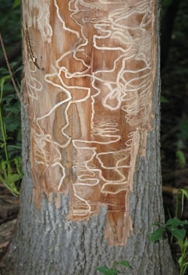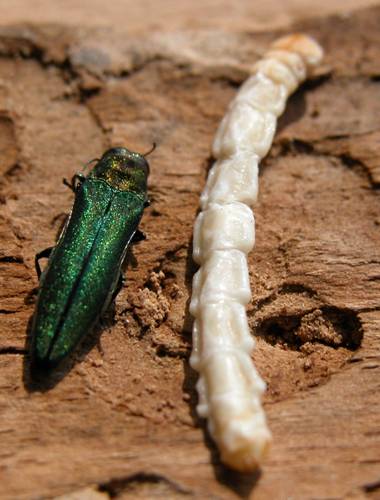LITTLE CURRENT—The announcement of the arrival of the emerald ash borer (EAB) on Manitoulin Island has left many residents pondering questions such as what is an EAB? Do I have an ash tree on my property? What can I do? In this article, The Expositor tried to answer some of these questions by speaking with leading experts is the field.
What is an emerald ash borer?
Agrilus Planipennis, or the emerald ash borer, is a beetle that is metallic green and about half an inch long and eighth of an inch wide. It is a highly destructive invasive species that originates in Asia and feeds on North American ash trees.
“EAB was first detected in 2002 in Windsor and Detroit,” explained Joe Meating, president of BioForest, who developed TreeAzin—a tree vaccination against the EAB in collaboration with the Canadian Forest Service (CFS)—and who now holds its worldwide licence. “EAB kills 99.9 percent of trees once an area is infected.”
According to the Canadian Food Inspection Agency (CFIA), the EAB affects all species of ash trees except mountain ash, which is not related to ash trees.
“It is believed to have been introduced into North America via wood packing materials,” stated Julia Ruhl, program officer with Plan Protection for the Canadian Food Inspection Agency. “It is considered a quarantine pest in Canada and the United States.”
How does emerald ash borer affect ash trees?
The EAB, “larvae feeds on the inner bark and sapwood along the entire bole and larger branches (greater than 2.5 cm diameter) in the crown,” explained the CFIA on their website.
“The larvae feeds on the cambium layer, which is responsible for distributing water throughout the tree,” Mr. Meating told The Expositor. “It feeds on this inner layer which is like the tree’s blood vessels, creating galleries in the wood and preventing the tree from distributing nutrients and water and eventually killing the tree.”
Do you have an ash tree on your property?
“Ash trees are a hardwood tree with multiple or compound leaves,” explained Taylor Scarr, a provincial forest entomologist at the Forest Health Unit in Sault Ste. Marie. “They contain 5 to 7 leaves per stem with an opposite arrangement (leaves or branches that are directly across form each other).” Compound leaves means that the branches contain a leaf with more than one leaflet and that all the leaflets are attached to a single leaf stem.
“The bark is a grey ash colour with a criss-cross diamond pattern,” added Mr. Scarr. “The buds are a furry light brown/black and the twigs are quite thick and stout.”
Mr. Scarr also explained that ash trees like to grow in moist soil areas such as valleys and along waterways.
How the EAB is detected
“EAB is often present in an area 3-4 years prior to detection,” stated Ms. Ruhl.
“After is it established data from the US suggests that the tree has up to six years,” said Mr. Meating. “It doesn’t matter if the tree is located in a rural or urban enjoinment, EAB affects the ash tree the same. I have been involved in forestry for over 40 years and it is by far the most impressive tree killer.”
One method used by the Canadian government for EAB detection is green prism traps that are placed in ash trees across the country. Mr. Scarr told The Expositor that they are baited with chemicals that mimic the tree’s natural smell.
“We have over 700 traps deployed across Canada,” explained Ms. Ruhl. “We place them in high risk sites such as camp grounds and golf courses.”
Signs that your ash tree may be infected with the EAB are epicormic shots, s-shaped tunnels through the tree and splits in the bark, according to the CFIA. Other identifiers include a d-shaped beetle exit hole, feeding notch in leafs, premature yellowing of foliage, dead branch, thinning crowns, heavy seed production and/or woodpecker and squirrel feeding.
“Krista Ryall, a research scientist at the Great Lakes Forestry Centre, developed a very effective method of EAB identification through branch sampling,” said Mr. Scarr.
He explained that by cutting two 50-centimeter sections from branches of an ash tree, Ms. Ryall found that the pieces can be stripped of their bark and examined for s-shaped EAB tunnels. The amount and size of the tunnels can indicate the condition of the tree and how long it has been infected for.
Can your Ash tree be saved and how?
The CFIA state that presently there is no cure for an EAB infestation, just quarantine and other methods of “slowing down the rate of the EAB spread.” However, there is a vaccination for trees against EAB, TreeAzin.
“The Canadian Forest Services was conducting research on tree injections when the EAB came along,” explained Mr. Meating. “With combined funding from the Canadian government and BioForest, a team of scientists employed by the government were able to use a chemical extracted from a neem tree (native to India) seed to create a vaccination for ash trees from EAB.”
Mr. Meating explained that in 2008, TreeAzin received approval for use in Canada, and since then BioForest has held the distribution licence and provides TreeAzin to over 60 tree care companies throughout Ontario.
“It’s a bi-annual treatment, like getting a flu vaccination,” Mr. Meating began. “It is injected under the bark, at the base of the tree under low pressure. Treatment takes around 20 minutes, followed by 24-48 hours for the vaccination to disperse throughout the tree.”
Only time will tell just how effective the vaccination truly is, but as of now, Mr. Meating said that trees that they been treated are having a 99 percent success rate.
“After TreeAzin is injected it moves into the conductive tissues and moves upwards with the flow of water and nutrients,” explained BioForest on their website. “It translocates rapidly throughout the tree, killing EAB larvae feeding on the tree’s tissues by regulating growth and disrupting normal molting. It also reduces EAB fertility and egg viability when adult females feed on the tree’s foliage.”
CFIA state that TreeAzin injections can cost upwards of $400 bi-annually, but BioForest note on their websites that the cost is subject to the tree care provider who is injecting the tree and dependent on the size of the Ash tree.
For more information of TreeAzin visit www.bioforest.ca and for information of EAB visit the CFIA at www.inspection.gc.ca.




